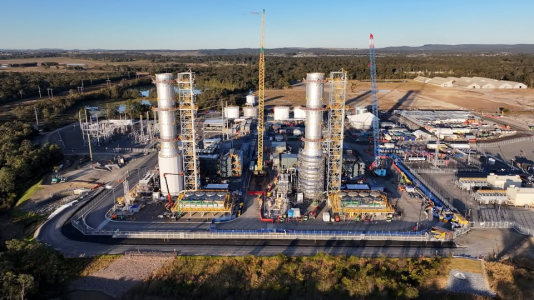Energy giant responds to alarming fuel-odour reports amid health fears
By
Gian T
- Replies 6
If you've ever noticed an odd smell in the air and wondered where it's coming from, you're not alone.
Some communities have recently faced that exact mystery, with suspicions quickly turning to a nearby industrial site.
As it turns out, those instincts may not have been far off.
The power station, which has just entered its testing phase, is designed to run on both gas and diesel.
But when the first round of tests fired up one of its two turbines using diesel, a pungent, eye-watering odour quickly wafted through the community.
Locals described the smell as so strong that it made their eyes water and left them feeling nauseous, even with all the windows shut tight.
One resident, Marlie Ford, told ABC Newcastle, ‘It was just eye-watering, I’ve never smelt anything that bad. Even with all the windows shut, it just made me feel really sick and nauseous.’
And Marlie wasn’t alone—many in the area reported similar experiences, sparking concern about the immediate discomfort and the potential health risks of such emissions.
Snowy Hydro’s CEO, Dennis Barnes, responded quickly, issuing a public apology and acknowledging that the company could have communicated better with the community.
‘We did do local communications and our near neighbours, but I think we’ve stuffed up by not going more broadly on social media and the radio to warn people that we were doing this,’ he admitted.
Barnes promised that next time, the company would use more channels to keep everyone in the loop.
But what about the environmental and health implications? According to Barnes, the plant's emissions were within the ecological limits set by authorities.
However, he conceded that this technical compliance doesn’t mean much to residents left coughing and rubbing their eyes.
‘At the plant itself, the emissions were within our environmental limits, but that doesn’t make any difference to the local community when they’re smelling and seeing smoke,’ he said.
The New South Wales Environmental Protection Authority (EPA) is investigating the incident.
The EPA confirmed that the plant is required to conduct continuous emissions monitoring, even during testing.
‘Before commissioning works recommence, we will review Snowy Hydro’s updated commissioning plan and discuss additional control measures,’ an EPA spokesperson said.
The investigation will also check whether the station’s emissions limits have been breached.
For those unfamiliar, the Kurri Kurri plant was commissioned by the former Coalition government as a ‘bridging station’, meant to help supply power during peak times as older coal-fired stations are phased out.
While the intention is to keep the lights on as Australia transitions to cleaner energy, incidents like this highlight the challenges of balancing energy needs with community health and environmental protection.
For many residents, the main concern is the impact on their health and quality of life.
Prolonged exposure to diesel fumes can cause headaches, nausea, and irritation of the eyes, nose, and throat.
For those with pre-existing respiratory conditions, such as asthma or COPD, the risks are even greater.
While the company insists emissions were within legal limits, the lived experience of locals tells a different story.
This incident also highlights the importance of clear, timely communication between large infrastructure projects and the communities they affect.
A simple heads-up via social media or local radio could have helped residents prepare, perhaps by closing windows, staying indoors, or simply knowing what to expect.
The EPA’s investigation is ongoing, and Snowy Hydro has pledged to improve its communication and review its procedures before any further testing.
The company is also working closely with the EPA to ensure that any future emissions are better controlled and that residents are kept informed.

Have you ever experienced something similar in your community? Do you think companies like Snowy Hydro are doing enough to protect local residents? We’d love to hear your thoughts and stories—share your experiences in the comments below.
Read more: ‘Lip-service won’t fix the air we breathe’: Frustration grows over pollution fears
Some communities have recently faced that exact mystery, with suspicions quickly turning to a nearby industrial site.
As it turns out, those instincts may not have been far off.
The power station, which has just entered its testing phase, is designed to run on both gas and diesel.
But when the first round of tests fired up one of its two turbines using diesel, a pungent, eye-watering odour quickly wafted through the community.
Locals described the smell as so strong that it made their eyes water and left them feeling nauseous, even with all the windows shut tight.
One resident, Marlie Ford, told ABC Newcastle, ‘It was just eye-watering, I’ve never smelt anything that bad. Even with all the windows shut, it just made me feel really sick and nauseous.’
And Marlie wasn’t alone—many in the area reported similar experiences, sparking concern about the immediate discomfort and the potential health risks of such emissions.
Snowy Hydro’s CEO, Dennis Barnes, responded quickly, issuing a public apology and acknowledging that the company could have communicated better with the community.
‘We did do local communications and our near neighbours, but I think we’ve stuffed up by not going more broadly on social media and the radio to warn people that we were doing this,’ he admitted.
Barnes promised that next time, the company would use more channels to keep everyone in the loop.
But what about the environmental and health implications? According to Barnes, the plant's emissions were within the ecological limits set by authorities.
However, he conceded that this technical compliance doesn’t mean much to residents left coughing and rubbing their eyes.
‘At the plant itself, the emissions were within our environmental limits, but that doesn’t make any difference to the local community when they’re smelling and seeing smoke,’ he said.
The EPA confirmed that the plant is required to conduct continuous emissions monitoring, even during testing.
‘Before commissioning works recommence, we will review Snowy Hydro’s updated commissioning plan and discuss additional control measures,’ an EPA spokesperson said.
The investigation will also check whether the station’s emissions limits have been breached.
For those unfamiliar, the Kurri Kurri plant was commissioned by the former Coalition government as a ‘bridging station’, meant to help supply power during peak times as older coal-fired stations are phased out.
While the intention is to keep the lights on as Australia transitions to cleaner energy, incidents like this highlight the challenges of balancing energy needs with community health and environmental protection.
For many residents, the main concern is the impact on their health and quality of life.
Prolonged exposure to diesel fumes can cause headaches, nausea, and irritation of the eyes, nose, and throat.
For those with pre-existing respiratory conditions, such as asthma or COPD, the risks are even greater.
While the company insists emissions were within legal limits, the lived experience of locals tells a different story.
This incident also highlights the importance of clear, timely communication between large infrastructure projects and the communities they affect.
A simple heads-up via social media or local radio could have helped residents prepare, perhaps by closing windows, staying indoors, or simply knowing what to expect.
The EPA’s investigation is ongoing, and Snowy Hydro has pledged to improve its communication and review its procedures before any further testing.
The company is also working closely with the EPA to ensure that any future emissions are better controlled and that residents are kept informed.
Key Takeaways
- Snowy Hydro's Kurri Kurri power station caused concern among locals after a strong fuel smell was emitted during testing, with some residents reporting feeling sick and nauseous.
- CEO Dennis Barnes apologised, admitting communication with the community should have been broader, and promised increased updates via social media during future tests.
- The NSW Environmental Protection Authority (EPA) is investigating the incident, ensuring emissions monitoring is in place and reviewing Snowy Hydro’s commissioning plan before further tests.
- While emissions during the test reportedly remained within environmental limits, residents were still significantly impacted by the odour and smoke, highlighting the importance of transparent communication and mitigation measures.
Read more: ‘Lip-service won’t fix the air we breathe’: Frustration grows over pollution fears
Last edited:








